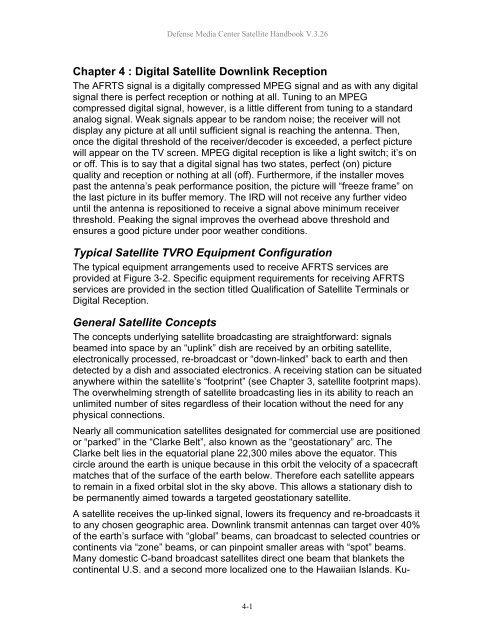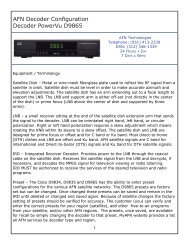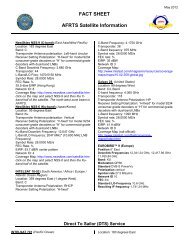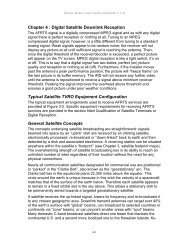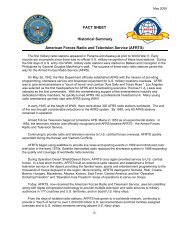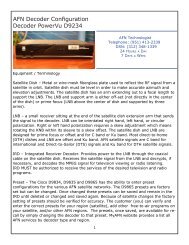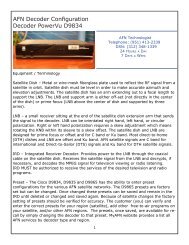AFRTS Defense Media Center Satellite Handbook
AFRTS Defense Media Center Satellite Handbook
AFRTS Defense Media Center Satellite Handbook
You also want an ePaper? Increase the reach of your titles
YUMPU automatically turns print PDFs into web optimized ePapers that Google loves.
<strong>Defense</strong> <strong>Media</strong> <strong>Center</strong> <strong>Satellite</strong> <strong>Handbook</strong> V.3.26<br />
Chapter 4 : Digital <strong>Satellite</strong> Downlink Reception<br />
The <strong>AFRTS</strong> signal is a digitally compressed MPEG signal and as with any digital<br />
signal there is perfect reception or nothing at all. Tuning to an MPEG<br />
compressed digital signal, however, is a little different from tuning to a standard<br />
analog signal. Weak signals appear to be random noise; the receiver will not<br />
display any picture at all until sufficient signal is reaching the antenna. Then,<br />
once the digital threshold of the receiver/decoder is exceeded, a perfect picture<br />
will appear on the TV screen. MPEG digital reception is like a light switch; it’s on<br />
or off. This is to say that a digital signal has two states, perfect (on) picture<br />
quality and reception or nothing at all (off). Furthermore, if the installer moves<br />
past the antenna’s peak performance position, the picture will “freeze frame” on<br />
the last picture in its buffer memory. The IRD will not receive any further video<br />
until the antenna is repositioned to receive a signal above minimum receiver<br />
threshold. Peaking the signal improves the overhead above threshold and<br />
ensures a good picture under poor weather conditions.<br />
Typical <strong>Satellite</strong> TVRO Equipment Configuration<br />
The typical equipment arrangements used to receive <strong>AFRTS</strong> services are<br />
provided at Figure 3-2. Specific equipment requirements for receiving <strong>AFRTS</strong><br />
services are provided in the section titled Qualification of <strong>Satellite</strong> Terminals or<br />
Digital Reception.<br />
General <strong>Satellite</strong> Concepts<br />
The concepts underlying satellite broadcasting are straightforward: signals<br />
beamed into space by an “uplink” dish are received by an orbiting satellite,<br />
electronically processed, re-broadcast or “down-linked” back to earth and then<br />
detected by a dish and associated electronics. A receiving station can be situated<br />
anywhere within the satellite’s “footprint” (see Chapter 3, satellite footprint maps).<br />
The overwhelming strength of satellite broadcasting lies in its ability to reach an<br />
unlimited number of sites regardless of their location without the need for any<br />
physical connections.<br />
Nearly all communication satellites designated for commercial use are positioned<br />
or “parked” in the “Clarke Belt”, also known as the “geostationary” arc. The<br />
Clarke belt lies in the equatorial plane 22,300 miles above the equator. This<br />
circle around the earth is unique because in this orbit the velocity of a spacecraft<br />
matches that of the surface of the earth below. Therefore each satellite appears<br />
to remain in a fixed orbital slot in the sky above. This allows a stationary dish to<br />
be permanently aimed towards a targeted geostationary satellite.<br />
A satellite receives the up-linked signal, lowers its frequency and re-broadcasts it<br />
to any chosen geographic area. Downlink transmit antennas can target over 40%<br />
of the earth’s surface with “global” beams, can broadcast to selected countries or<br />
continents via “zone” beams, or can pinpoint smaller areas with “spot” beams.<br />
Many domestic C-band broadcast satellites direct one beam that blankets the<br />
continental U.S. and a second more localized one to the Hawaiian Islands. Ku-<br />
4-1


